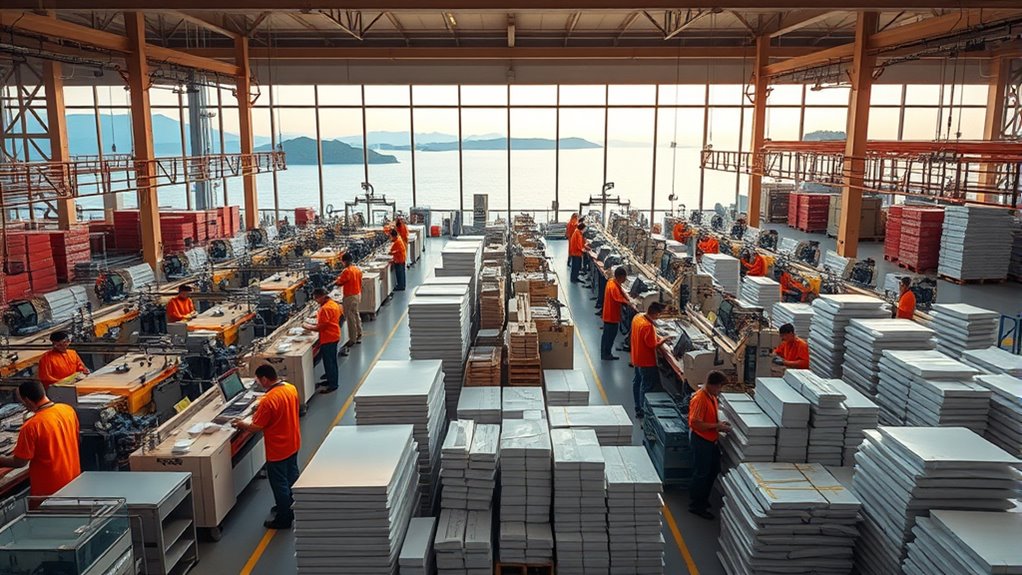After the crunch, supply chains are shifting toward nearshoring to improve resilience and reduce costs. You’ll notice companies moving away from distant Asian suppliers to regional partners, cutting lead times and transportation expenses. This change helps you prevent stockouts and adapt quickly to market shifts. Smarter inventory management and regional sourcing strengthen your supply chain’s stability. If you want to understand how these practices can benefit you, keep exploring the strategies behind this shift.
Key Takeaways
- Companies are shifting from global to regional sourcing to reduce lead times and transportation costs.
- Nearshoring enhances supply chain resilience by minimizing exposure to international disruptions.
- Inventory management strategies now favor buffer stocks and real-time data to ensure responsiveness.
- Regional sourcing allows for leaner inventories, lowering holding costs and improving agility.
- Long-term benefits include increased supply chain transparency, stability, and faster adaptation to market changes.

The recent supply chain disruptions have forced companies to rethink their logistics strategies and build more resilient systems. One of the most significant shifts has been in how you approach inventory management. Instead of relying on just-in-time practices that depend heavily on global supply chains, you’re now prioritizing more flexible and responsive inventory systems. This means holding buffer stocks of critical components or finished goods to withstand delays and uncertainties. By doing so, you reduce the risk of stockouts and ensure your operations remain steady even when disruptions occur elsewhere. Improving inventory management isn’t just about increasing stock levels; it’s about implementing smarter tracking systems, real-time data analysis, and demand forecasting. These tools help you optimize inventory levels, minimize excess, and quickly adapt to changing market conditions. Additionally, integrating advanced color accuracy calibration tools can further enhance inventory tracking through precise color matching in packaging and labeling processes.
Building resilient supply chains with smarter inventory management reduces stockouts and boosts operational stability amidst disruptions.
Alongside this, regional sourcing has become a strategic priority. Instead of sourcing from distant suppliers primarily in Asia or other continents, you’re increasingly turning to nearby regions or domestic suppliers. This shift shortens lead times, reduces transportation costs, and minimizes exposure to international disruptions like port congestions or geopolitical tensions. Regional sourcing allows you to establish closer relationships with suppliers, which often results in better communication, faster response times, and more reliable delivery schedules. It also grants you more control over your supply chain, giving you the agility needed to respond swiftly to market changes or unforeseen events. You may find yourself exploring local manufacturing hubs or partnering with regional suppliers who can provide quality materials more quickly and at competitive prices.
Implementing regional sourcing strategies also influences how you manage your inventory. With shorter supply chains, you can reduce safety stock levels without risking stockouts, leading to leaner inventories and lower holding costs. This creates a more balanced approach, where you’re not only reducing risks but also optimizing your capital allocation. Additionally, regional sourcing often aligns with sustainability goals, as it tends to lower carbon footprints associated with transportation.
In practice, integrating regional sourcing with improved inventory management requires careful planning. You’ll need to analyze supplier reliability, transportation logistics, and regional market dynamics to build a resilient supply chain. It’s about creating a network that’s adaptable, transparent, and capable of responding to disruptions quickly. By focusing on these areas, you set up a supply chain that’s less vulnerable to global shocks and more aligned with your business’s needs. This proactive approach ensures that you can meet customer demands, maintain competitive advantages, and build a foundation for long-term stability in an increasingly uncertain world.
Frequently Asked Questions
How Does Nearshoring Impact Local Economies Long-Term?
Nearshoring boosts your local economy long-term by creating more local jobs and encouraging infrastructure investment. As companies move operations closer, you’ll see increased employment opportunities, which can uplift communities. Infrastructure improvements, like transportation and utilities, support this growth, making the area more attractive for future investments. Over time, this strengthens your local economy’s resilience, fostering sustainable development and increased prosperity for residents.
What Are the Main Risks of Nearshoring Compared to Offshoring?
You face risks in nearshoring, like maneuvering cost fluctuations and political instability, which can shake your plans like unpredictable storms. Unlike offshoring, where costs are often stable, nearshoring’s proximity exposes you to local political shifts that could disrupt your supply chain. These risks create a turbulent rhythm, challenging your ability to forecast costs and maintain steady operations, making careful risk assessment essential for long-term success.
How Do Companies Evaluate the Success of Nearshoring Strategies?
You evaluate your nearshoring success by tracking cost savings and supplier reliability. If costs decrease while maintaining quality and delivery schedules, your strategy works. Regularly review supplier performance metrics, ensuring they meet your standards for reliability and responsiveness. Additionally, gather feedback from stakeholders to confirm shorter lead times and improved flexibility. Continuous monitoring helps you adjust your approach, maximizing benefits like cost efficiency and dependable supply chains.
What Industries Benefit Most From Nearshoring After the Crunch?
Like Icarus flying close to the sun, you’ll find manufacturing and electronics industries soar with nearshoring. These sectors benefit from improved manufacturing efficiency and reduced labor costs, making production more agile and cost-effective. You’ll also see automotive and textiles thrive, as nearshoring shortens supply chains and boosts responsiveness. If you want to stay competitive, nearshoring lets you harness these advantages, ensuring your business stays ahead of the curve.
How Does Nearshoring Affect Global Supply Chain Resilience?
Nearshoring boosts your supply chain resilience by enabling better supply chain diversification, reducing dependence on distant regions. It helps you respond faster to disruptions and adapt to market changes. Considering labor costs, nearshoring balances affordability with proximity, saving you time and transportation costs. This strategic move strengthens your overall supply chain, making it more agile and less vulnerable to global shocks.
Conclusion
As you navigate the post-crunch landscape, nearshoring proves to be a game-changer, transforming supply chains into agile, resilient forces. Embrace these shifts or risk falling behind in a world where disruptions strike like lightning. By bringing production closer, you stand to revolutionize your operations—making them faster, smarter, and more reliable. Don’t let your supply chain become a relic of the past; seize the nearshoring revolution before it’s too late.








